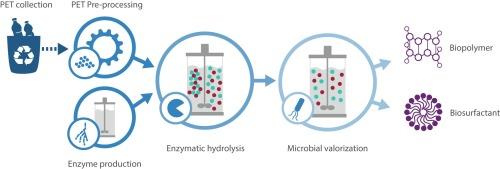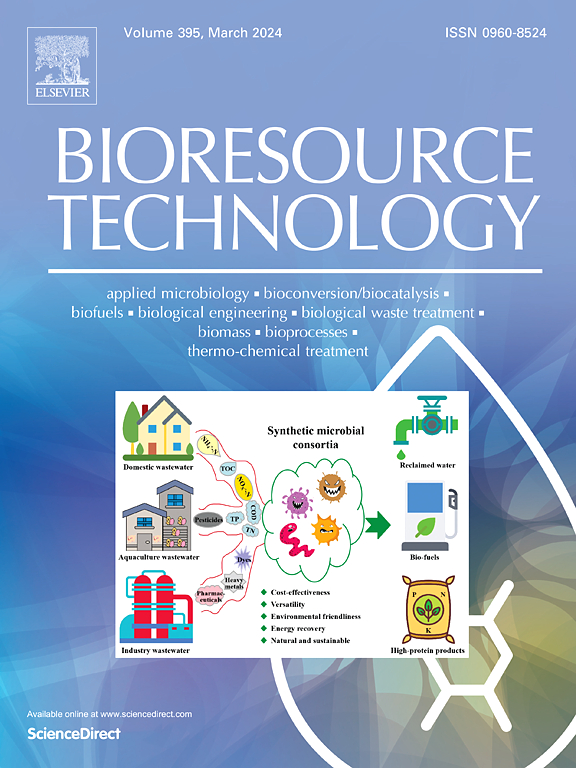利用基因工程和生物工艺工程,将消费后聚对苯二甲酸乙二醇酯分两步生物催化转化为高附加值产品。
IF 9.7
1区 环境科学与生态学
Q1 AGRICULTURAL ENGINEERING
引用次数: 0
摘要
解决塑料危机需要较高的回收配额和开放式循环回收技术。本文介绍了一种生物塑料增值方法,包括串联酶水解和将消费后聚对苯二甲酸乙二酯单体转化为增值产品。在搅拌槽反应器中对预处理过的消费后聚对苯二甲酸乙二酯瓶子进行酶法降解后得到的水解物作为碳源,与经过改造的假单胞菌株进行批量发酵,生产出 90 毫克/升的生物聚合物蓝藻素。通过喂料批次操作,发酵可强化至 1.4 克/升的蓝藻霉素。此外,还介绍了将聚对苯二甲酸乙二醇酯单体升级循环为生物表面活性剂(羟基烷酰氧基)烷酸酯和鼠李糖脂的过程。这些可生物降解的产品在洗涤剂、新型聚合物构件和组织工程等领域具有巨大的应用潜力。总之,所介绍的生物增值工艺强调,应对塑料危机等挑战需要采取跨学科的方法。本文章由计算机程序翻译,如有差异,请以英文原文为准。

Two-step biocatalytic conversion of post-consumer polyethylene terephthalate into value-added products facilitated by genetic and bioprocess engineering
Solving the plastic crisis requires high recycling quotas and technologies that allow open loop recycling. Here a biological plastic valorization approach consisting of tandem enzymatic hydrolysis and monomer conversion of post-consumer polyethylene terephthalate into value-added products is presented. Hydrolysates obtained from enzymatic degradation of pre-treated post-consumer polyethylene terephthalate bottles in a stirred-tank reactor served as the carbon source for a batch fermentation with an engineered Pseudomonas putida strain to produce 90 mg/L of the biopolymer cyanophycin. Through fed-batch operation, the fermentation could be intensified to 1.4 g/L cyanophycin. Additionally, the upcycling of polyethylene terephthalate monomers to the biosurfactants (hydroxyalkanoyloxy)alkanoates and rhamnolipids is presented. These biodegradable products hold significant potential for applications in areas such as detergents, building blocks for novel polymers, and tissue engineering. In summary, the presented bio-valorization process underscores that addressing challenges like the plastic crisis requires an interdisciplinary approach.
求助全文
通过发布文献求助,成功后即可免费获取论文全文。
去求助
来源期刊

Bioresource Technology
工程技术-能源与燃料
CiteScore
20.80
自引率
19.30%
发文量
2013
审稿时长
12 days
期刊介绍:
Bioresource Technology publishes original articles, review articles, case studies, and short communications covering the fundamentals, applications, and management of bioresource technology. The journal seeks to advance and disseminate knowledge across various areas related to biomass, biological waste treatment, bioenergy, biotransformations, bioresource systems analysis, and associated conversion or production technologies.
Topics include:
• Biofuels: liquid and gaseous biofuels production, modeling and economics
• Bioprocesses and bioproducts: biocatalysis and fermentations
• Biomass and feedstocks utilization: bioconversion of agro-industrial residues
• Environmental protection: biological waste treatment
• Thermochemical conversion of biomass: combustion, pyrolysis, gasification, catalysis.
 求助内容:
求助内容: 应助结果提醒方式:
应助结果提醒方式:


